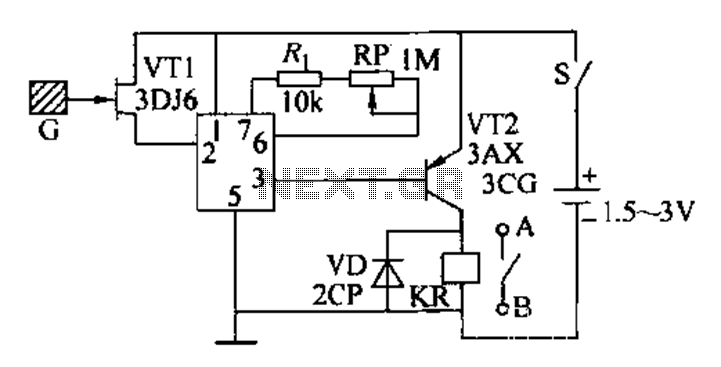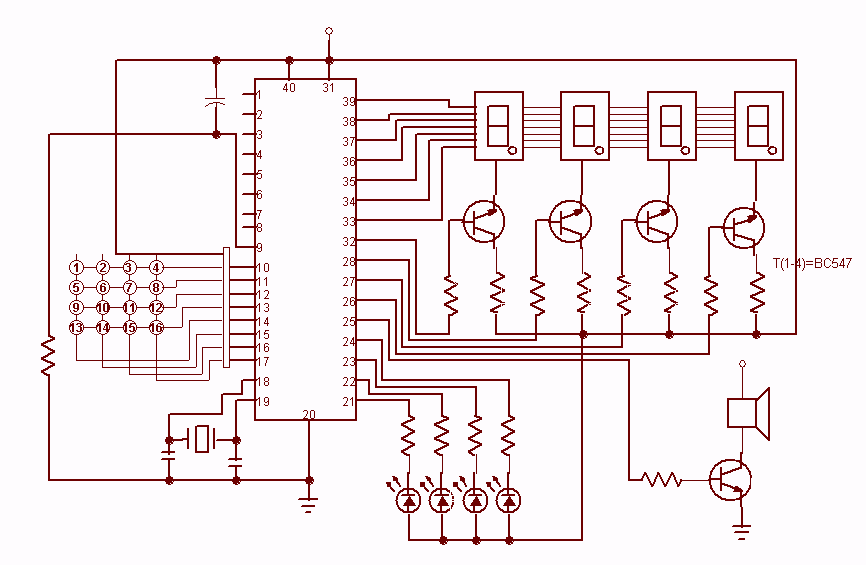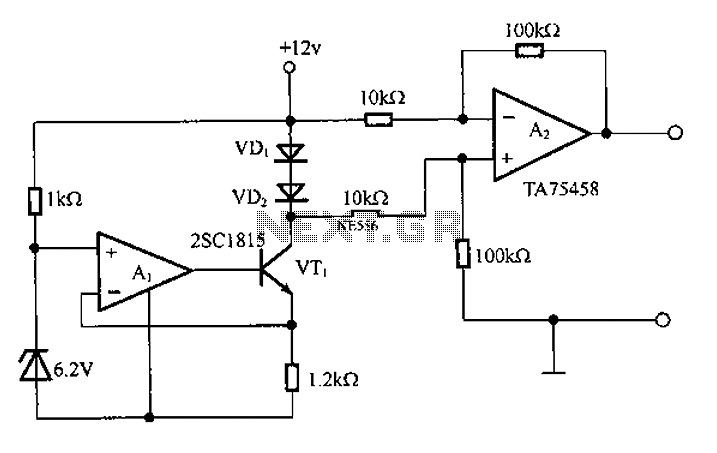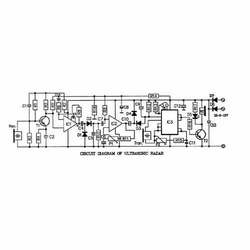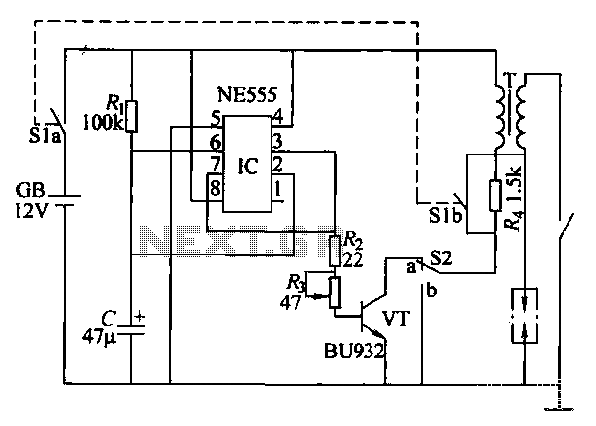
555 simple electronic keyboard circuit (2)
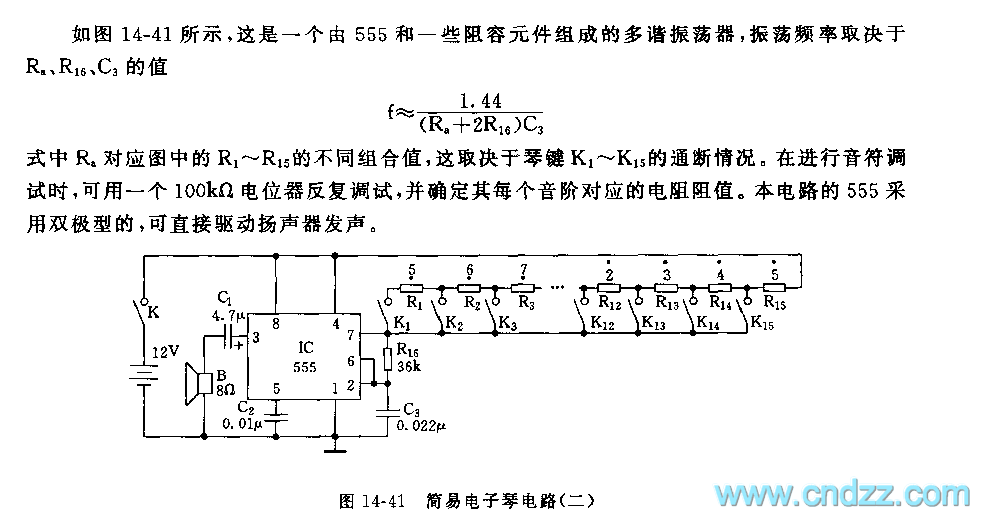
Figure 14-41 illustrates a multivibrator circuit utilizing a 555 timer alongside various capacitive and resistive components. The oscillation frequency is determined by the values of Ra, R16, and C3, following the formula f = 1.44 / ((Ra + 2R16) * C3). The variable Ra corresponds to different resistor values ranging from R1 to R15, which are influenced by the states of keys K1 to K15. During debugging, specific notes can be taken into account.
The multivibrator circuit based on the 555 timer is a versatile configuration used for generating pulse-width modulation signals, oscillations, and timing applications. The core of the circuit relies on the 555 timer IC, which can operate in astable, monostable, or bistable modes. In this configuration, it operates in astable mode, where it continuously oscillates between high and low states, generating a square wave output.
The frequency of oscillation, as indicated, is calculated using the formula f = 1.44 / ((Ra + 2R16) * C3). Here, Ra is the resistance value that can be adjusted by selecting different resistors from R1 to R15, allowing for flexibility in the circuit's frequency response. R16 serves as an additional resistor that influences the timing characteristics, while C3 is the timing capacitor that works in conjunction with the resistors to set the frequency of oscillation.
The keys K1 to K15 can serve as input controls that modify the resistance value of Ra. When a key is pressed, it can either connect or disconnect certain resistors in parallel or series, thus changing the effective resistance and, consequently, the frequency of the output signal. This feature allows for user interaction, enabling dynamic adjustments to the oscillation frequency based on operational requirements.
During the debugging phase, it is crucial to monitor the output waveform using an oscilloscope to ensure that the desired frequency and duty cycle are achieved. Adjustments can be made to the resistor and capacitor values to fine-tune the performance of the multivibrator. Additionally, it is advisable to take note of any anomalies in the output that could indicate issues with component values or connections within the circuit. Proper documentation of these observations will facilitate troubleshooting and optimization of the multivibrator circuit.As the figure 14-41 shows, the multivibrator is composed of the 555 and some capacitance resistance components, the oscillation frequency depends on the values of Ra, R16 and C3. f=1.44/(Ra+2R16)C3, the Ra of the formula corresponds to the different values of R1-R15, this depends on the situation of the keys K1-K15.
When you are debugging the notes, you can.. 🔗 External reference
The multivibrator circuit based on the 555 timer is a versatile configuration used for generating pulse-width modulation signals, oscillations, and timing applications. The core of the circuit relies on the 555 timer IC, which can operate in astable, monostable, or bistable modes. In this configuration, it operates in astable mode, where it continuously oscillates between high and low states, generating a square wave output.
The frequency of oscillation, as indicated, is calculated using the formula f = 1.44 / ((Ra + 2R16) * C3). Here, Ra is the resistance value that can be adjusted by selecting different resistors from R1 to R15, allowing for flexibility in the circuit's frequency response. R16 serves as an additional resistor that influences the timing characteristics, while C3 is the timing capacitor that works in conjunction with the resistors to set the frequency of oscillation.
The keys K1 to K15 can serve as input controls that modify the resistance value of Ra. When a key is pressed, it can either connect or disconnect certain resistors in parallel or series, thus changing the effective resistance and, consequently, the frequency of the output signal. This feature allows for user interaction, enabling dynamic adjustments to the oscillation frequency based on operational requirements.
During the debugging phase, it is crucial to monitor the output waveform using an oscilloscope to ensure that the desired frequency and duty cycle are achieved. Adjustments can be made to the resistor and capacitor values to fine-tune the performance of the multivibrator. Additionally, it is advisable to take note of any anomalies in the output that could indicate issues with component values or connections within the circuit. Proper documentation of these observations will facilitate troubleshooting and optimization of the multivibrator circuit.As the figure 14-41 shows, the multivibrator is composed of the 555 and some capacitance resistance components, the oscillation frequency depends on the values of Ra, R16 and C3. f=1.44/(Ra+2R16)C3, the Ra of the formula corresponds to the different values of R1-R15, this depends on the situation of the keys K1-K15.
When you are debugging the notes, you can.. 🔗 External reference
